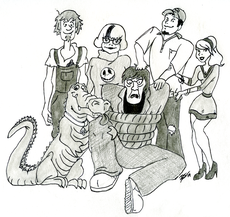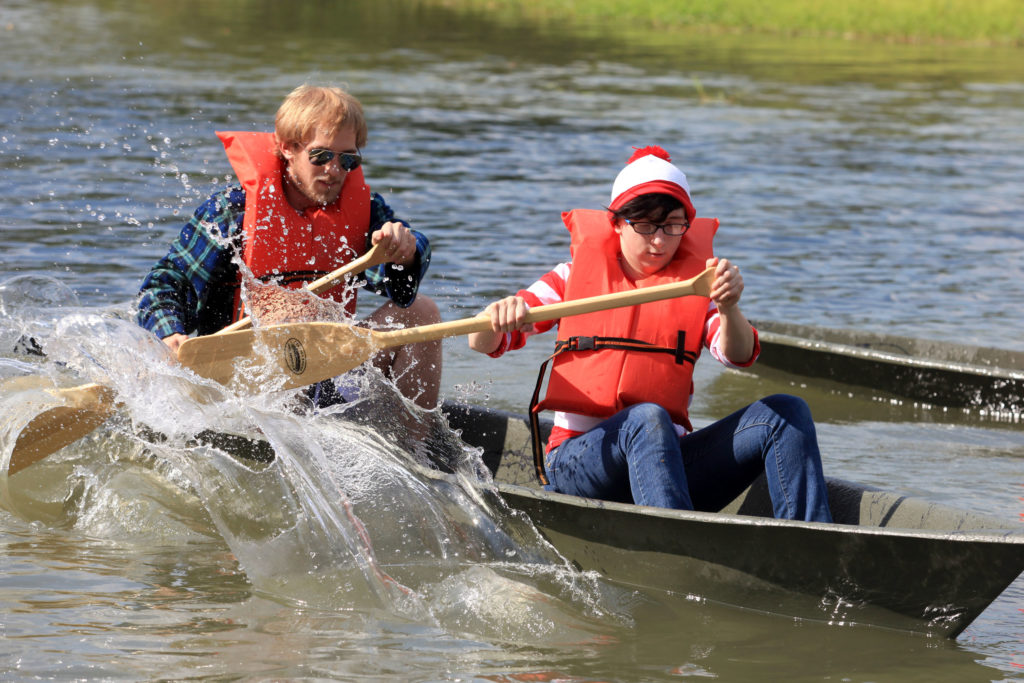Cally Chauvin sees dead people. At least, she tries to. “Ever since I was a little girl, I’ve always experienced things,” Cally says.
“I remember one night, when I was 17 years old, my parents went to the camp while I stayed at home, upstairs by myself. I had turned off all the lights and gone to bed.
“I had this sheet on top of me, and I was really cold. Shaking, even. And as I began to fall asleep, something pulled the covers up and tucked me in, like my grandmother used to. Literally pulled them up to my neck.”
It was not the first time. Nor the last.
Cally: “I’m able to communicate with them, and I don’t know why. Maybe it’s because I’m very open and childlike. Or maybe it’s because I lived in a haunted house. Now it’s a funeral home, which it probably should have been all along.”
Today, nearly 30 years later, Cally calls herself a schoolteacher by day, ghost hunter by night. She leads a team of 17 professional paranormal investigators collectively called Bayou Spirits. Since its creation in November 2007, the all-woman organization has investigated 20 locations in South Louisiana, including hotels, restaurants and private residences: Hotel Villa Convento in New Orleans, Ormond Plantation in Destrehan and the National Guard Armory in Hammond, to name a few.
Their goal: “To help people that other people would just throw on the side and say, ‘you’re crazy, you need medication, you’re seeing things, you’re delusional,'” Cally says, dressed in jeans and a black T-shirt with “Bayou Spirits” in translucent white letters across the front. “These people may be as sane as you and I, and I want to help people like that. That’s what I was born to do.”
First thing’s first. The Cajun ghostbusters unpack their equipment-four infrared cameras, voice recorders to catch electronic voice phenomena (EVPs), walkie-talkies, flashlights, electromagnetic field (EMF) detectors, digital thermometers, 400 yards of wire to hook up devices to the DVR, notebooks and extra batteries.
Lots of batteries, Cally insists: “They drain quickly when there is a lot of activity because the ghosts need the energy to manifest.”
They set up their equipment, hooking up each camera to a monitoring station that controls and records the video and audio from each device. Finally, they turn off all the lights, separate into groups, take a short moment of silence to become acquainted with the atmosphere and then begin asking questions: “Is anyone here? Can you show us a sign?”
Cally waits patiently for a reply-a reply she most likely will not hear but hopes will surface when she listens to her voice recorder once the investigation is over. She puts the recorder down, leaving it on to catch any possible EVPs, and then turns on the digital thermometer, which reads 73.8 degrees. She waits for a shift in temperature and anticipates a chill or a sweat, knowing that would mean they’re here.
Nothing.
Then the EMF detector. The light is green, and she waits, hoping it might turn red. They still aren’t here.
Or are they?
“If it would be so easy to find spirits, then it wouldn’t be paranormal; it would be normal,” Cally explains. “But that’s just it. I really believe it depends on certain moments in time, if they’re willing to communicate or not and if you have an open mind or not. There’s a lot of people that are closed-minded, and I think a spirit could be fully manifested right in front of them, and they’ll just say it was the light.”
At four o’clock a.m. every day, the sound of footsteps thump, thump, thumps up the stairway. The familiar squeaks and creaks from the stairs echo throughout the house like a melody, until finally, the music stops. Some call it coincidence. Cally calls it a residual haunting.
Residual spirits do not know they are dead, Cally explains, and they tend to continuously replay a particular event, usually at the same time or in the same place. They have a purpose-they need help crossing over, in which case Bayou Spirits talks to the entities to make them aware of their situations and to help them go to the light.
Make the footsteps change location. First the stairwell, then the dining room. Or make them occur only when someone asks a question. That would be an intelligent haunting. The entities know they are dead and just “want to be recognized,” Cally points out. No need trying to ask them to leave. A lot of times they do not want to. Other times, they already have, and they are just returning for a little visit.
In each team member’s notebook is a log that describes such paranormal activity-both residual and intelligent. Spiritual orbs, shadowy figures, laughing ghost children and other unexplained phenomena. However, the investigators cannot be quick to cry wolf. The group has to try to debunk the activities to examine if they are, in fact, plausible. A change in temperature could indicate an entity is present or simply that an air conditioner is nearby, just as an orb on a photograph could be a spirit trying to manifest or a dust orb that merely got in the way.
Cally: “You try to debunk as much as you can. I’m a science teacher at heart, so I want to believe, but I also don’t want something to be fake or not real. I’m going to find out as much as I can if it’s real or not. And if it’s unexplained, that’s the stuff you really have to question.”
The group’s most bizarre experience it could not debunk: “We were at the Myrtles, in the caretaker’s cottage. I’m sitting there with four other members of my group and they’re filming,” Cally says, walking over to her grandson Jamie’s black backpack, which he had thrown on the couch when he got home from school earlier that day.
“All of a sudden, the camera went completely dead. Completely drained of power. And on Jamie’s bag, this zipper was doing like this.” Cally takes the zipper and begins shaking it. She speeds up the motion, whipping it back and forth, causing the bag to rouse. “And then it started moving 100 miles per hour. We tried taking pictures with our cell phones; it wouldn’t work. Nothing would work.
“Then three of our members came through the door, and it stopped. Immediately. Dead. Just like that.”
She speaks of the Myrtles like a child speaks of candy, and a picture of the St. Francisville plantation hangs over her fireplace. She talks about the slave girl, Chloe, who haunts it, along with two small children and their mother who died from eating poisonous birthday cake Chloe made for the oldest child.
That moment in the slave cottage tops Bayou Spirits’ list of claims of activity, including a whistling ghost boy and floating toasters. Although, even after witnessing what they deem to be supernatural, the group remains nonetheless unafraid.
“It’s not a fear. It’s a rush. Better than anything in the world,” Cally describes, settling back in her chair, as if she is recalling a memory from her youth. “Imagine you’re jumping off of something. That feeling you get right before you hit the ground. It’s like that. Like a parachute. You’re just exhilarated. And finally you’re just high. And you come down, but slowly. You get the frissons, like they say in French. And you’re just pumped. That feeling. You can’t bottle it. Boy, if I could bottle that, I’d be rich.








